24시간 식이제한 후 저항성 운동이 혈중 성장 호르몬, IGF-1, 코르티솔 및 테스토스테론에 미치는 영향
Abstract
PURPOSE
The purpose of this study was to investigate the effects of 24-hour food restriction on plasma human Growth hormone, IGF-1, cortisol and testosterone responses in resistance exercise.
METHODS
The 13 college male students (Age; 24.7±1.2 years, Height; 174.1±2.0 cm, Body Weight; 70.4±1.5 kg) were randomly received to the control treatment (CON) and 24 hours fasting treatment (24-FT). The CON served the 400-kcal steam rice as the Korean traditional breakfast 3 hours prior to performing the resistance exercise, while the 24-FT did not eat any food except the water for 24 hours. The resistance exercise session consisted of squat exercise with 5 sets×6-8 repetitions with 80% of one repetition maximum. Blood samples were drawn before (pre), and immediately after exercise (0 minute) and at 15 minutes, 30 minutes, 60 minutes, 120 minutes after exercise. Plasma human growth hormone (hGH), total testosterone, cortisol, IGF-1, insulin, glucose and free fatty acid (FFA) concentrations were measured.
RESULTS
Plasma hGH levels in 24-FT were significantly higher after exercise compared with the CON at 0, 15, 30, 60 minutes (p<.05). Cortisol levels in 24-FT were significantly higher than in the CON at before (pre) and 0 minute (p<.05). The plasma IGF-1 and testosterone levels were not significantly significantly different between two treatments.
CONCLUSIONS
The results of this investigation suggested that the elevation of hGH might not be related to anabolic effects in food restriction. In addition, it seems that hGH response in resistance exercise is strongly affected by carbohydrate ingestion.
색인어: 식이제한, 저항성운동, 성장호르몬, 동화작용호르몬
Keywords: Food restriction, Resistance exercise, Growth hormone, Anabolic hormone
서 론
에너지 섭취 제한은 신체의 근육과 근력 감소뿐만 아니라 운동수행능력의 저하를 야기시킨다[ 1, 2]. 그러나 스포츠 현장의 체급경기 운동 선수들은 식이제한을 통한 체중 감량 방법을 널리 이용하고 있으며, 대부분 체급경기 운동선수는 좋은 경기 결과의 체급을 만들기 위해 단기간 많은 체중을 감량할 수 있는 고강도 훈련과 식이제한을 동시에 실시하는 것이 일반적인 사실이다. 고강도 저항성 운동은 성장 호르몬(human growth hormone, hGH)과 테스토스테론(testosterone)과 같은 동화작용 호르몬을 증가시켜 근력과 파워 그리고 근비대와 근지구력을 증가시키는 적응 반응을 일으키며, 이러한 생리적인 반응은 골격근의 리모델링(remodelling)은 신경내분비계에 의해 조절된다[ 3, 4]. 특히, 내분비계 호르몬은 저항성 운동에 민감하게 반응하며 근육내 동화작용(anabolism)과 이화작용(catabolism)의 대사적 과정에 관여하는데[ 5] 대부분 선행연구에서 저항성 운동이 일시적으로 성장 호르몬, Insulin-like Growth Factor-1 (IGF-1), 테스토스테론(testosterone), 코르티솔(cortisol) 등의 호르몬 변화를 일으킨다고 보고하고 있다[ 6- 11]. 저항성 운동은 근육내 단백질 합성을 증가시킬 뿐만 아니라 장기간의 트레이닝은 근력 증가와 근섬유 비대를 일으켜 운동선수의 경기력을 향상시키는 데 효과적인 것으로 보고하고 있다[ 10, 12, 13]. 반면, 최근 저항성 운동에 의한 근육 단백질 합성은 동화작용 성질을 내포한 성장호르몬, 코르티솔, 테스토스테론, 인슐린과 같은 호르몬 반응과 관련성이 낮다고 보고하고 있다[ 14]. 그러나 대부분의 선행연구를 살펴보면, 적절한 영양 섭취와 저항성 운동은 동화작용 호르몬의 분비를 자극하는데 이러한 호르몬들은 단백질 합성을 통하여 근육내 단백질 저장을 증가시키는 데 긍정적인 효과가 있다고 보고하고 있다[ 15- 17]. 선행연구에 의하면, 저항성 운동 전후 탄수화물 섭취는 혈중 인슐린 농도와 근육세포의 아미노산 이동을 증가시켜 운동 시 단백질 분해를 감소시킨다고 보고하고 있지만[ 17- 21], 최근 2016년도 단백질과 탄수화물을 8주간 과섭취(overfeeding)한 실험에서는 추가적인 단백질 합성이나 근비대의 징후는 나타나지 않았다고 보고하고 있다[ 22]. 하지만 운동 중 근육내 단백질 합성을 증가시키기 것도 중요하지만 근육 감소를 최소화하는 데 있어 운동강도, 지속시간, 운동 형태뿐만 아니라 운동 시 적절한 영양섭취도 중요하다고 할 수 있다. 그러나, 국내 저항성 운동과 관련된 선행 연구는 저항성 운동이 현대인들의 질병 예방에 미치는 효과 규명 연구들이 대부분이며 운동 선수들의 경기 전 체중 조절 기간과 칼로리 섭취 제한에 의한 체중감량, 그리고 운동 시 근육내 단백질 합성 호르몬의 반응에 대한 연구는 거의 없는 실정이다. 따라서 본 연구에서는 24시간 식이제한 후 저항성 운동이 혈중 단백질 합성 관련 호르몬의 변화에 어떠한 영향을 미치는 알아보고자 한다.
연구 방법
1. 연구 대상
본 연구에서는 신체 건강한 D 광역시 K 대학교 남자 대학생 13명을 대상으로 실시하였으며 실험 전 실험에 대한 내용을 충분히 설명한 후 실험에 자발적으로 참여한다는 내용의 동의서를 받았다. 본 연구는 집단내 실험설계(within subject design)로 실시하였고, 모든 연구 대상자는 실험 전 식이와 신체활동을 통제하기 위해 K 대학교의 기숙사 생활을 하였다. 실험 처치는 무작위로 선정하여 일반식이(control treatment, CON)와 24시간 식이제한 처치(24 hours food restriction treatment, 24-FT)로 나누어 실시하였다. 각 처치 간격을 7일로 하였고, 연구 대상자의 신체적 특성은 다음과 같다( Table 1).
2. 실험처치
24시간 식이제한(24-FT)은 24시간 동안 물 이외의 모든 식이는 제한하였으며, 일반식이(CON)는 실험 1일 전 12시간 금식 후 실험 당일 운동 3시간 전 400 kcal의 쌀밥과 소고기 국물을 아침식사로 제공하였다. 모든 연구 대상자는 운동 전 충분한 준비 운동을 실시하였다. 운동 종목은 저항성 운동 중 인체의 대근육을 사용하는 하지 근력 운동 스쿼트(squat)로 하였다. 정확한 운동 강도를 설정하기 위해 모든 연구 대상자는 Earle의 방법을 이용하여 1RM을 측정하였다[ 23]. 운동 프로토콜은 1RM의 80% (8 RM) 운동강도로 5세트×6-8회 최대 반복하였다. 연구 대상자는 세트 간 휴식시간은 1분으로 하였다. 연구 대상자는 1RM 측정 전 48시간 동안 피로한 신체활동과 격렬한 운동을 제한하였다. 운동 프로토콜은 Table 2와 같다.
3. 혈액채취 및 측정방법
1) 혈액채취
24시간 식이제한(24-FT)은 24시간 금식 후 운동 전 안정 시 채취하였으며 일반식이(CON)는 3시간 전 400 kcal 탄수화물을 섭취한 후 24시간 식이 제한 처치와 동일한 시간대에 상완 정맥에서 10 mL의 혈액을 채취하였다. 혈액은 혈액 응고를 방지하기 위해 EDTA 항응고제 튜브에 담아 원심 분리하여 -70℃ 냉동 보관하였으며 혈액 채취는 운동 전(EX-pre), 운동 직후(Ex-post), 운동 후 15분, 30분, 60분, 120분에 채취하였다.
2) 측정항목 및 방법
혈중 성장 호르몬과 IGF-1은 ELISA Kit (Mediagnost, Germany)를 이용하여 효소면역측정법(Enzyme immunoassay)으로 분석하였고 ELISA 흡광도 450 nm에서 발색반응을 측정하였다. 혈당은 자동 혈당 분석기(YSI 2300, Springfield, USA)를 이용하여 측정하였고, 유리지방산은 Noma 방법을 이용하여 측정하였다[ 24]. 혈중 인슐린, 코르티솔 그리고 테스토스테론은 Coat-A-Count Kit (Diagnostic Products Corporation, USA)를 이용하여 방사선면역측정법(Radioimmunoassay)으로 분석하였고, γ-counter (1470 Wizard, Wallac, automatic count Finland)에서 1분 동안 측정하였다.
4. 자료처리방법
각 측정항목에 대한 결과는 평균과 표준오차(Mean±SE)를 산출하였으며, 통계적 분석은 SPSS 17.0 통계프로그램을 이용하였다. 통계처리는 집단 간 처치 후 변화를 알아보기 위해 two-way ANOVA with repeated measures를 실시한 후 contrast와 paired t-test를 이용하여 시간(time)과 처치(treatment) 간의 차이를 사후 검증을 하였으며 모든 유의수준은 .05로 하였다.
연구 결과
1. 혈중 성장 호르몬의 변화
혈중 성장 호르몬은 CON과 비교하여 24-FT에서 운동 직후, 운동 후 15분, 30분, 60분이 유의하게 높게 나타났다( p< .05). 개체내 CON은 운동 전과 비교하여 유의한 차이가 없는 것으로 나타났으나 24-FT는 운동 전과 비교하여 운동 후 15분, 30분에서 성장 호르몬이 유의하게 증가한 것으로 나타났으며( p< .05) 운동 직후와 비교하여 운동 후 15분에서도 유의하게 증가한 것으로 나타났다( p< .05) ( Fig. 1).
2. 혈중 인슐린 양성장 인자(IGF-1)의 변화
혈중 IGF-1은 CON과 비교하여 24-FT에서 유의한 차이가 없는 것으로 나타났다. 개체내 CON은 운동 전과 비교하여 유의한 차이가 없는 것으로 나타났으나 24-FT는 운동 전과 비교하여 운동 후 30분에서 IGF-1이 감소한 것으로 나타났다( p< .05) ( Fig. 2).
3. 혈중 유리지방산의 변화
혈중 유리지방산은 CON과 비교하여 24-FT에서 운동 전, 운동 직후, 운동 후 15분, 30분, 120분에서 유의하게 높게 나타났다(p< .05) 개체내에서는 두 처치 모두 운동 전과 비교하여 유의한 차이가 없는 것으로 나타났다( Fig. 3).
4. 혈당의 변화
혈당은 CON과 비교하여 24-FT에서 운동 직후 유의하게 높게 나타났으나, 운동 후 60분과 120분에서 낮게 나타났다( p < .05). 개체내 CON은 운동 전과 비교하여 운동 후 15분, 30분, 60분에서 혈당이 증가한 것으로 나타났으며( p< .05) 24-FT는 운동 전과 비교하여 운동 직후, 운동 후 15분과 30분에서 유의하게 증가한 것으로 나타났다( p< .05) ( Fig. 4).
5. 혈중 인슐린의 변화
혈중 인슐린은 CON과 비교하여 24-FT에서 운동 후 15분, 30분, 60분, 120분에서 유의하게 낮게 나타났다( p< .05). 개체내 CON에서는 운동 전과 비교하여 운동 후 15분과 30분에서 혈중 인슐린이 증가한 것으로 나타났으며( p < .05) 운동 후 15분과 30분, 운동 후 30분과 60분, 운동 후 60분과 120분에서 유의한 차이가 있는 것으로 나타났다( p< .05). 그러나 24-FT는 운동 전과 비교하여 운동 후 유의한 차이가 없는 것으로 나타났다( Fig. 5).
6. 혈중 코르티솔의 변화
혈중 코르티솔은 CON과 비교하여 24-FT에서 운동 전, 운동 직후 유의하게 높게 나타났다( p< .05). 개체내 CON은 운동 전과 비교하여 운동 직후, 운동 후 15분과 30분에서 혈중 코르티솔이 증가한 것으로 나타났다( p< .05) ( Fig. 6).
7. 혈중 테스토스테론의 변화
혈중 테스토스테론은 CON과 비교하여 24-FT에서 유의한 차이가 없는 것으로 나타났으며 개체내에서도 두 처치 모두 유의한 차이가 없는 것으로 나타났다( Fig. 7).
논 의
저항성 운동 시 성장 호르몬 분비의 증가는 단백질 합성(systhesis), 근육내 단백질 분해(degration) 등 단백질 대사에 영향을 주며 저항성 운동의 형태, 운동강도, 운동량에 따라 다양하게 나타난다[ 25]. 대부분 선행 연구에서는 저항성 운동 후 30분 이내에 혈중 성장호르몬이 분비가 급격히 증가하며 운동강도에 따라 성장호르몬의 분비가 다르게 나타난다고 보고하고 있다[ 8, 17, 26]. 본 연구에서는 24시간 식이제한 후 8RM 5세트 스쿼트(squat) 운동을 실시한 결과 24시간 식이제한이 일반식이에 비교하여 운동 직후 15분, 30분, 60분에서 성장호르몬의 농도가 높게 나타났으며 운동 전과 비교하여 운동 후 15-30분에 유의하게 증가한 것으로 나타났다. 반면, 일반식이는 운동 전과 비교하여 운동 후 15분에서 증가하는 경향이 나타났으나 통계적으로 유의한 차이가 없는 것으로 나타났다. 선행연구에 의하면, 성장호르몬은 스트레스 자극에 영향을 받으며 운동 시 단백질 합성에 중요한 요소로 보고되고 있다[ 16, 17]. 반면, 탄수화물 섭취 제한은 근글리코겐을 감소시킨다고 보고하고 있으며 동일한 강도의 운동 시 근육 내 글리코겐의 함량이 낮을수록 주관적 운동강도가 유의하게 높은 것으로 보고하고 있다[ 27]. 본 연구의 결과 24시간 식이제한 후 저항성 운동 시 성장호르몬의 분비가 증가한 것을 알 수 있었다. 이는 24시간 식이제한이 성장호르몬의 분비를 증가시키고 단백질 동화작용을 발생시키는 것으로 생각할 수 있으나 Loy et al. [ 27]의 연구결과에서처럼 24시간 식이제한이 일반식이에 비해 동일한 운동강도에서의 느끼는 주관적 생리학적 반응 높았기 때문에 성장호르몬의 분비가 증가한 것으로 생각된다. 결과적으로 본 연구의 성장호르몬 분비의 증가는 운동강도에 의한 자극보다 신체 보유 에너지인 근글리코겐 함량이 더 크게 작용했기 때문에 24시간 식이제한에서 성장호르몬이 증가한 것으로 생각된다. IGF-1는 운동이나 대사적 스트레스 상황에서 글루코스 조절에 중요한 역할을 하며 혈중 성장 호르몬의 농도와 관련성 있다고 보고하고 있다[ 28, 29]. 반면, 다른 저항성 운동과 관련된 연구에서는 상반되는 결과가 보고되고 있다[ 5, 15, 29- 32]. Kraemer et al. [ 30]은 일회성 저항성 운동 후 성장 호르몬의 분비는 증가했으나 IGF-1은 유의한 차이가 없는 것으로 나타났다. 반면, Rubin et al. [ 30]은 운동 직후 IGF-1의 농도가 증가한 것으로 나타났다. 결과적으로 혈중 IGF-1의 분비는 혈중 성장 호르몬의 농도[ 30, 34]와 운동에 의해 분비된 성장 호르몬의 절대적, 상대적 불응기(refractory period) 효과에 따라 다르게 나타난다고 할 수 있다[ 28, 29]. 본 연구 결과에서는 두 처치 모두 혈중 IGF-1은 증가하지 않은 것으로 나타났다. 이는 Kraemer et al. [ 33]과 Cappon et al. [ 28]의 연구와 일치하는 것으로 혈중 IGF-1의 농도는 성장 호르몬의 분비와 독립적으로 작용하는 것으로 생각된다. 혈중 코르티솔 분비는 운동 시간이 짧거나 운동량이 작을 경우 감소되고, 운동 시간이 길거나 운동량이 많을 경우 증가한다고 보고하고 있다[ 6, 7, 17, 33, 35, 36]. Williams et al. [ 17]은 고강도 운동이 저강도 운동보다 코르티솔 분비를 증가시키며 Tarpenning et al. [ 37]은 일회성 저항성 운동 후 혈중 코르티솔의 분비가 증가한다고 보고하였다. 또한, Kraemer et al. [ 15]의 연구에서는 운동 2시간 전 과 운동 직후 탄수화물을 섭취시킨 결과 두 집단 모두 혈중 코르티솔의 수준이 증가한 것으로 나타났다. 본 연구의 결과 운동 3시간 전 400 kcal 탄수화물을 섭취시킨 일반식이에서는 운동 전과 비교하여 운동 직후, 운동 후 15분과 30분에서 혈중 코르티솔의 수준이 증가한 것으로 나타났다. 이는 저항성 운동이 혈중 코르티솔의 분비를 증가시킨다는 선행연구와 일치하는 것을 알 수 있었다. 코르티솔은 혈중 글루코스와 근글리코겐을 보호하기 위해 간당신생작용을 촉진시켜 hepatic lipolysis와 proteolysis를 증가시키며 12시간의 공복 후 혈중 코르티솔의 분비가 유의하게 높게 나타났다고 보고하였다[ 16]. 결론적으로 본 연구의 24시간 식이제한 후 혈중 코르티솔(Ex-pre, Ex- post)의 증가는 식이 제한으로 인한 스트레스와 탄수화물 대사의 감소로 인해 골격근의 당신생작용을 촉진시켜 혈중 유리지방산과 아미노산을 증가시키고 간에서의 혈중 글루코스 방출(glucoogenesis)을 증가시킨 것으로 생각된다. 이는 본 연구의 인슐린과 유리지방산 결과가 뒷받침해 주고 있다. 테스토스테론은 저항성 운동 시 일시적으로 증가한다고 보고하고 있으나 운동 경험 유무, 운동 강도, 기간, 형태, 개인에 따라 차이가 난다[ 3, 5, 6, 10, 15, 26, 38, 39]. Bosco et al. [ 7]과 Ratamess et al. [ 36]은 일회성 저항성 운동은 운동 강도와 운동량이 높을수록 테스토스테론의 분비는 증가하나, 다양한 형태의 운동 자극은 테스토스테론 분비에 관여하는 뇌하수체-레이딩 세포 축(Hypophysis-Leyding Cell axis)을 자극하기 때문에 운동 시 분비되는 안드로겐 수용체(androgen receptor) 작용과 관련이 있다는 것이다[ 9, 36]. 본 연구의 결과에서는 두 처치 모두 운동 전과 비교하여 운동 후 회복기에서 혈중 테스토스테론이 증가하지 않은 것으로 나타났다. 그러나 두 처치 모두 통계적으로 유의한 차이가 없었으나 운동 전과 비교하여 운동 직후 혈중 테스토스테론이 5.7%와 6.9% 증가한 경향은 나타났다. 따라서, 본 연구의 일회성 저항성(8RM×5 sets, squat)은 테스토스테론의 분비에 영향을 미치지 못한 것으로 생각된다. 그러므로 운동 강도, 운동량, 안드로겐 수용체 그리고 테스토스테론 분비에 대한 연구가 필요할 것으로 생각된다. 본 연구에서 안정 시 혈중 인슐린과 혈당의 반응은 400 kcal 식사 섭취 후 3시간에 두 처치 간 유의한 차이가 없는 것으로 나타났다. 일반적으로 선행연구에서는 12시간 금식 후 포도당 75 g (약 300 kcal)으로 혈당내성검사를 실시한 결과 2시간 후 혈당과 인슐린 반응이 유의하게 증가되어 정상으로 회복하지 못하는 것으로 보고되고 있다[ 40- 43]. 이러한 혈당과 인슐린 반응의 차이는 피검자의 신체적 특성에 기인한 것으로 사료된다. 대부분 혈당과 인슐린 반응의 차이를 나타난 연구에 참여한 연구대상자의 신체적 특성은 임신 중이거나 인슐린 저항이 있는 것으로 나타났으나(ref), 젊은 훈련된 연구 대상으로 한 Herd et al. [ 44]의 연구에서는 3-4시간 후 혈중 인슐린과 혈당 수준이 12시간 금식한 수준으로 감소한 것으로 나타났다. 이러한 결과는 본 연구의 결과와 비슷한 것으로 사료된다.
결 론
본 연구는 신체 건강한 남자 대학생을 대상으로 24시간 식이제한 후 저항성 운동(8RM 5 세트, 스쿼트)이 단백질 합성에 미치는 효과를 알아보기 위해 성장호르몬, IGF-1, 코르티솔, 테스토스테론을 분석한 결과 다음과 같은 결론을 얻었다.
24시간 식이제한은 혈중 코르티솔의 분비와 유리지방산 농도를 증가시키는 것으로 나타났으며 일반식이에 비해 저항성 운동 후 성장호르몬의 분비가 증가하는 것을 알 수 있다. 결론적으로 식이제한으로 신체 에너지 근글리코겐 감소가 단백질 합성인자인 성장호르몬의 분비와 밀접한 관련이 있는 것으로 생각된다, 그러나 본 연구는 일반식이 테스토스테론의 결과에서 알 수 있듯이 운동 처치와 식이제한의 관련성을 설명하기는 본 연구의 운동강도, 운동량 설정이 아쉬운 점이라 판단된다.
그러므로 추후 본 연구의 결과를 바탕으로 운동강도, 운동기간, 운동량 등을 고려한 세부적인 연구가 필요할 것으로 생각된다.
Fig. 1.
Fig. 1.Plasma human Growth hormone (hGH) concentrations. Control treatment, CON; 24 hours food restriction treatment, 24-FT. Data are shown as means±SE (n=13). *p<0.05 vs. CON; ap<0.05 vs. Ex-pre; bp<0.05 vs. Ex-post 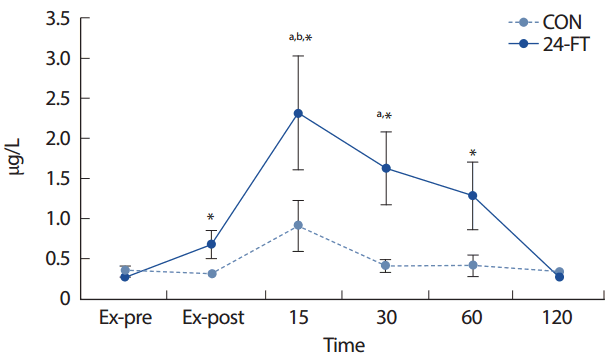
Fig. 2.
Fig. 2.Plasma Insulin-like factor-1 (IGF-1) consentraions. Control treatment, CON; 24 hours food restriction treatment, 24-FT. Data are shown as means ±SE (n=13). ap<.05 vs. Ex-pre. 
Fig. 3.
Fig. 3.Plasma Free Fatty acid (FFA) concentrations. Control treatment, CON; 24 hours food restriction treatment, 24-FT. Data are shown as means± SE (n=13). *p<.05 vs. CON 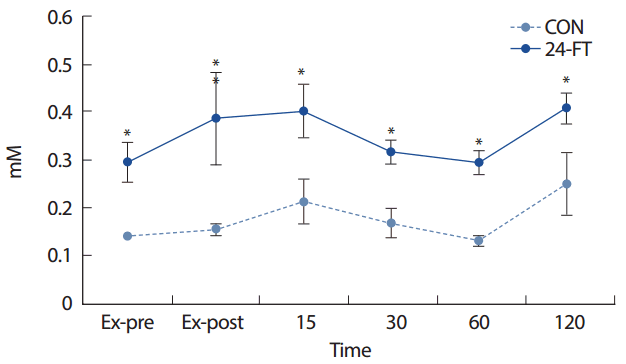
Fig. 4.
Fig. 4.Plasma glucose concentrations. Control treatment, CON; 24 hours food restriction treatment, 24-FT. Data are shown as means±SE (n=13). *p<.05 vs. CON; ap<.05 vs. Ex-pre. 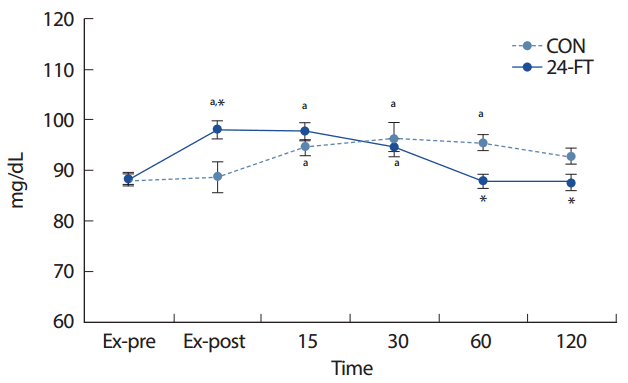
Fig. 5.
Fig. 5.Plasma insulin concentrations. Control treatment, CON; 24 hours food restriction treatment, 24-FT. Data are shown as means±SE (n=13). *p<.05 vs. CON; ap<.05 vs. Ex-pre; bp<.05 vs. 15 min, cp<.05 vs. 30 min, dp<.05 vs. 60 min. 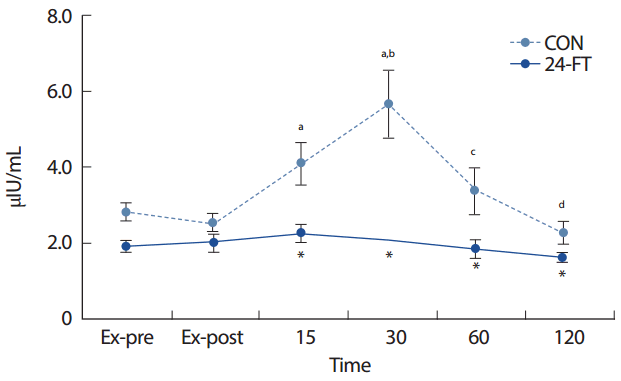
Fig. 6.
Fig. 6.Plasma cortisol concentrations. Control treatment, CON; 24 hours food restriction treatment, 24-FT. Data are shown as means±SE (n=13). *p<.05 vs. CON; ap<.05 vs. Ex-pre. 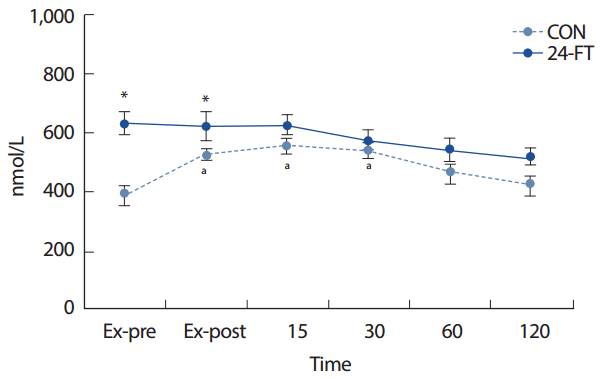
Fig. 7.
Fig. 7.Plasma total testosterone concentrations. Control treatment, CON; 24 hours food restriction treatment, 24-FT. Data are shown as means±SE (n=13). 
Table 1.
Baseline characteristics of participants
|
Variables |
Subjects |
|
Age (year) |
24.7 ± 0.4 |
|
Weight (kg) |
70.4 ± 1.5 |
|
Height (cm) |
176.7 ± 1.2 |
Table 2.
Resistance exercise protocol
|
Set |
Intensity (% RM) |
|
Repetition |
|
Warm up |
50% |
× |
10 |
|
1 |
80% |
× |
8 |
|
2 |
80% |
× |
8 |
|
3 |
80% |
× |
7-8 |
|
4 |
80% |
× |
6-8 |
|
5 |
80% |
× |
6-8 |
REFERENCES
1. Abedelmalek S, Chtourou H, Souissi N, Tabka Z. Caloric Restriction Effect on Proinflammatory Cytokines, Growth Hormone, and Steroid Hormone Concentrations during Exercise in Judokas. Oxidative Medicine and Cellular Longevity. 2015;809492.   2. McMurray RG, Proctor CR, Wilson WL. Effect of caloric deficit and dietary manipulation on aerobic and anaerobic exercise. International Journal of Sports Medicine. 1991;12(2):167-172.   3. Kraemer WJ, Ratamess NA. Hormonal responses and adaptations to resistance exercise and training. Sports Medicine. 2005;35(4):339-361.   4. Mauras N. Growth hormone and sex steroids. Interactions in puberty. Endocrinology and Metabolism Clinics of North America. 2001;30(3):529-544.   5. Kraemer WJ, Gordon SE, Fleck SJ, Marchitelli LJ, Mello R, et al. Endogenous anabolic hormonal and growth factor responses to heavy resistance exercise in males and females. International journal of Sports Medicine. 1991;12(2):228-235.   6. Ahtiainen JP, Pakarinen A, Alen M, Kraemer WJ, Hakkinen K. Short vs. long rest period between the sets in hypertrophic resistance training: influence on muscle strength, size, and hormonal adaptations in trained men. The Journal of Strength & Conditioning Research. 2005;19(3):572-582.   7. Bosco C, Colli R, Bonomi R, von Duvillard SP, Viru A. Monitoring strength training: neuromuscular and hormonal profile. Medicine and Science in Sports and Exercise. 2000;32(1):202-208.   8. Kraemer WJ, Marchitelli L, Gordon SE, Harman E, Dziados JE, et al. Hormonal and growth factor responses to heavy resistance exercise protocols. Journal of Applied Physiology. 1990;69(4):1442-1450.  9. Smilios I, Pilianidis T, Karamouzis M, Tokmakidis SP. Hormonal responses after various resistance exercise protocols. Medicine and Science in Sports and Exercise. 2003;35(4):644-654.   10. Tremblay MS, Copeland JL, Van Helder W. Effect of training status and exercise mode on endogenous steroid hormones in men. Journal of Applied Physiology. 2004;96(2):531-539.   11. McKndry J, Perez-Lopez A, McLeod M, Luo D, Dent JR, et al. Short inter-set rest blunts resistance exercise-induced increases in myofibrillar protein synthesis and intracellular signalling in young males. Experimental Physiology. 2016;101(7):866-882.   12. Phillips SM, Hartman JW, Wilkinson SB. Dietary protein to support anabolism with resistance exercise in young men. Journal of the American College of Nutrition. 2005;24(2):134S-139S.   13. Phillips SM, Tipton KD, Aarsland A, Wolf SE, Wolfe RR. Mixed muscle protein synthesis and breakdown after resistance exercise in humans. American Journal of Physiology-Endocrinology and Metabolism. 1997;273(1 Pt 1):E99-107.
14. Mangine GT, Hoffman JR, Gonzalez AM, Townsend JR, Wells AJ, et al. The effect of training volume and intensity on improvements in muscular strength and size in resistance-trained men. Physiological Reports. 2015;3(8):1-16.  15. Kraemer WJ, Volek JS, Bush JA, Putukian M, Sebastianelli WJ. Hormonal responses to consecutive days of heavy-resistance exercise with or without nutritional supplementation. Journal of Applied Physiology. 1998;85(4):1544-1555.  16. Volek JS. Influence of nutrition on responses to resistance training. Medicine and Science in Sports and Exercise. 2004;36(4):689-696.   17. Williams AG, Ismail AN, Sharma A, Jones DA. Effects of resistance exercise volume and nutritional supplementation on anabolic and catabolic hormones. European Journal of Applied Physiology. 2002;86(4):315-321.   18. Ahtiainen JP, Pakarinen A, Kraemer WJ, Hakkinen K. Acute hormonal and neuromuscular responses and recovery to forced vs maximum repetitions multiple resistance exercises. International Journal of Sports Medicine. 2003;24(6):410-418.   19. Roy BD, Tarnopolsky MA, MacDougall JD, Fowles J, Yarasheski KE. Effect of glucose supplement timing on protein metabolism after resistance training. Journal of Applied Physiology. 1997;82(6):1882-1888.   20. Schumm SR, Triplett NT, McBride JM, Dumke CL. Hormonal response to carbohydrate supplementation at rest and after resistance exercise. International Journal of Sport Nutrition and Exercise Metabolism. 2008;18(3):260-280.   21. Roy BD, Fowles JR, Hill R, Tarnopolsky MA. Macronutrient intake and whole body protein metabolism following resistance exercise. Medicine and Science in Sports and Exercise. 2000;32(8):1412-1418.   22. Spilane M, Willoughby DS. Daily Overfeeding from Protein and/or Carbohydrate Supplementation for Eight Weeks in Conjunction with Resistance Training Does not Improve Body Composition and Muscle Strength or Increase Markers Indicative of Muscle Protein Synthesis and Myogenesis in Resistance-Trained Males. Journal of Sports Science & Medicine. 2016;15(1):17-25.   23. Earle RW. Weight training exercise prescription. In: Essentioals of personal training symposium work book. Lincoln, NE: NACA Cetification Commission 1999.
24. Noma A, Okabe H, Kita M. A new colorimetric micro-determination of free fatty acids in serum. Clinica Chimica Acta. 1973;43(3):317-320.  25. Crewther B, Keogh J, Cronin J, Cook C. Possible stimuli for strength and power adaptation: acute hormonal responses. Sports Medicine. 2006;36(3):215-238.   26. Hakkinen K, Pakarinen A. Acute hormonal responses to two different fatiguing heavy-resistance protocols in male athletes. Journal of Applied Physiology. 1993;74(2):882-887.  27. Loy SF, Conlee RK, Winder WW, Nelson AG, Arnall DA, et al. Effects of 24-hour fast on cycling endurance time at two different intensities. Journal of Applied Physiology. 1986;61(2):654-659.  28. Cappon J, Brasel JA, Mohan S, Cooper DM. Effect of brief exercise on circulating insulin-like growth factor I. Journal of Applied Physiology. 1994;76(6):2490-2496.   29. Kraemer WJ, Aguilera BA, Terada M, Newton RU, Lynch JM, et al. Responses of IGF-I to endogenous increases in growth hormone after heavy-resistance exercise. Journal of Applied Physiology. 1995;79(4):1310-1315.  30. Rubin MR, Kraemer WJ, Maresh CM, Volek JS, Ratamess NA, et al. High-affinity growth hormone binding protein and acute heavy resistance exercise. Medicine and Science in Sports and Exercise. 2005;37(3):395-403.   31. Frystyk J, Grofte T, Skjaerbaek C, Orskov H. The effect of oral glucose on serum free insulin-like growth factor-I and -II in health adults. The Journal of Clinical Endocrinology & Metabolism. 1997;82(9):3124-3127.  32. Frystyk J, Nyholm B, Skjaerbaek C, Baxter RC, Schmitz O, et al. The circulating IGF system and its relationship with 24-h glucose regulation and insulin sensitivity in healthy subjects. Clinical Endocrinology. 2003;58(6):777-784.   33. Kraemer WJ, Fleck SJ, Dziados JE, Harman EA, Marchitelli LJ, et al. Changes in hormonal concentrations after different heavy-resistance exercise protocols in women. Journal of Applied Physiology. 1993;75(2):594-604.  34. Marcus R, Butterfield G, Holloway L, Gilliland L, Baylink DJ, et al. Effects of short term administration of recombinant human growth hormone to elderly people. The Journal of Clinical Endocrinology & Metabolism. 1990;70(2):519-527.   35. Bottaro M, Martins B, Gentil P, Wagner D. Effects of rest duration between sets of resistance training on acute hormonal responses in trained women. Journal of Science and Medicine in Sport. 2009;12(1):73-78.   36. Ratamess NA, Kraemer WJ, Volek JS, Maresh CM, Vanheest JL, et al. Androgen receptor content following heavy resistance exercise in men. The Journal of Steroid Biochemistry and Molecular Biology. 2005;93(1):35-42.   37. Tarpenning KM, Wiswell RA, Hawkins SA, Marcell TJ. Influence of weight training exercise and modification of hormonal response on skeletal muscle growth. Journal of Science and Medicine in Sport. 2001;4(4):431-446.   38. Hakkinen K, Pakarinen A, Kraemer WJ, Newton RU, Alen M. Basal concentrations and acute responses of serum hormones and strength development during heavy resistance training in middle-aged and elderly men and women. Journals of Gerontology-Biological Sciences and Medical Sciences. 2000;55(2):B95-105.  39. Hansen S, Kvorning T, Kjaer M, Sjogaard G. The effect of short-term strength training on human skeletal muscle: the importance of physiologically elevated hormone levels. Scandinavian Journal of Medicine & Science in Sports. 2001;11(6):347-354.   40. Rivas E, Newmire DE, Crandall CG, Hooper PL, Ben-Ezra V. An acute bout of whole body passive hyperthermia increases plasma leptin, but does not alter glucose or insulin responses in obese type 2 diabetics and healthy adults. Journal of Thermal Biology. 2016;59:26-33.   41. Nakamura Y, Kakoki M, Yamakado M. The effect of age on glucose tolerance and plasma insulin level in hypertensive and normotensive subjects. Hypertension Research. 1996;19 Suppl 1:S23-26.   42. Malin SK, Rynders CA, Weltman JY, Barrett EJ, Weltman A. Exercise Intensity Modulates Glucose-Stimulated Insulin Secretion when Adjusted for Adipose, Liver and Skeletal Muscle Insulin Resistance. PLoS One. 2016;11(4):e0154063.  44. Herd SL, Lawrence JE, Malkova D, Murphy MH, Mastana S, et al. Postprandial lipemia in young men and women of contrasting training status. Journal of Applied Physiology. 2000;89(5):2049-2056. 
|
|












